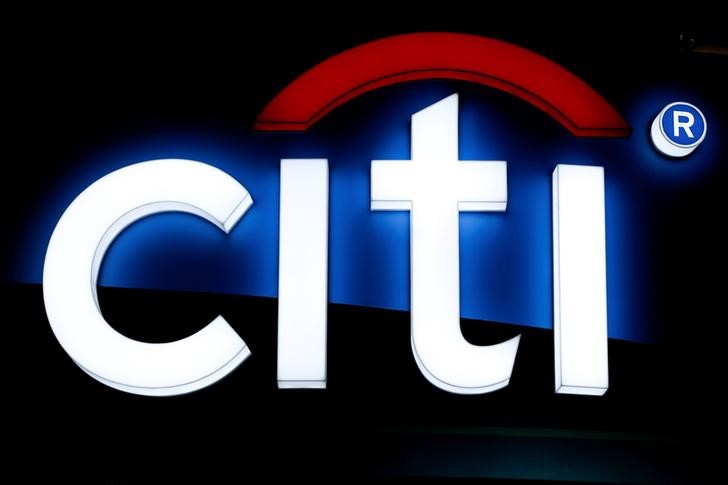© Reuters. FILE PHOTO: A woman walks past Wells Fargo bank in New York City, U.S., March 17, 2020. REUTERS/Jeenah Moon/File Photo
2/3
By Noor Zainab Hussain, Tatiana Bautzer and Saeed Azhar
(Reuters) -Some of the largest U.S. banks said on Friday they got a profit boost from higher rates and painted a picture of a resilient economy, with sparks of hope in some businesses like deal-making that have been in the dumps of late.
But they also warned of risks ahead, with U.S. consumers pulling back on spending and losses building up in areas such as credit cards and office commercial real estate.
Investors brushed aside their initial enthusiasm for results from JPMorgan Chase (NYSE:), Wells Fargo (NYSE:) and Citigroup (NYSE:), fearing things were as good as they would get for a while.
“We’re in a very unusual environment – higher inflation, these rate levels and a strong labor market,” Citigroup CEO Jane Fraser said. But she added, “I don’t think we should be overly concerned here about the health of the U.S. consumer.”
JPMorgan Chase and Wells Fargo reported sharp increases in net interest income, which measures the difference between what banks earn on loans and pay out on deposits, that drove up profits.
For Citigroup, however, weakness in its trading business overshadowed gains in interest income. That’s a headwind that other banks more dependent on Wall Street businesses, such as Goldman Sachs (NYSE:) and Morgan Stanley (NYSE:), are also likely to face when they report results next week.
Separately, BlackRock (NYSE:), the world’s biggest asset manager, handily beat second-quarter profit estimates but showed a slowdown in money inflows.
U.S. custodian bank State Street Corp (NYSE:) beat profit estimates for the second quarter after interest income climbed 18% year-on-year, though it fell on a quarterly basis by 10% due to lower average non-interest bearing deposit balances.
State Street warned of a further decline of 12-18% on net interest income on a sequential basis on its earnings call, driven by lower deposit levels. Deposits at large banks have been dropping as consumers move money in search of higher yields.
State Street shares closed down 12%, while JPM’s shares rose 0.6%. Wells shares were down 0.3%, while Citi fell 4% and BlackRock fell 1.5%.
“If interest rates rise, loan demand could continue to deteriorate,” said Brian Mulberry, client portfolio manager at Zacks Investment Management.
The bank results provide the latest insights into the health of the U.S. economy. Investors have been worried that an aggressive rate hike campaign by the U.S. Federal Reserve to fight inflation will tip the economy into recession but the outlook remains highly uncertain.
“The U.S. economy continues to be resilient,” JPMorgan Chief Executive Jamie Dimon said. But he added that consumers are “slowly using up their cash buffers.”
CONSUMER WORRIES
Some bank executives said U.S. consumers, who are the key drivers of the economy, still have healthy finances but warned spending was slowing and there had been a modest deterioration in some consumer debt.
Weekly data from the Federal Reserve has shown consumer borrowing slowing. Bank credit card lending saw its growth rate peak in October 2022 after two years of strong increases and has moderated since. The main drag on consumer lending is auto loans. Annual growth peaked there in early 2022 and turned negative in April.
Wells Fargo said consumer charge-offs, meaning debts that a bank has written off and does not expect to recover, continued to modestly deteriorate. Citi flagged that delinquency rates in credit cards and other retail lines are rising and expected to reach “normal levels” by the end of the year.
Wells CEO Charlie Scharf said the range of scenarios for the economy should narrow over the next few quarters. For now, the economy is performing better than many expected but will likely continue slowing.
Larry Fink, BlackRock’s chief executive, said in an interview with CNBC he expects the economic environment to remain challenging. “Inflation will be stickier than market is assuming,” he said, adding it will bounce around 2% and 4%.
Meanwhile, deposit levels have fallen for big banks for more than a year, and the annual growth rate turned negative last October and hit negative 6% in April, the steepest drop ever.
JPMorgan said it expects a modest downward trend in deposits.
RISKS AHEAD
Investment banking and trading businesses, a drag on earnings in recent quarters, did so again. Some executives held out hope, saying they had seen early signs of recovery in parts of those businesses but shied away from calling it a turning point.
JPMorgan’s Barnum said the bank was seeing “green shoots” in trading and investment banking but it was too early to call a trend.
Both JPMorgan and Wells Fargo also set aside more money for expected losses from commercial real estate loans, in the latest sign that stress is building up in the sector.
Wells reported that provision for credit losses included a $949 million increase in the allowance, mainly for potential losses in commercial real estate (CRE) office loans, as well as for higher credit card loan balances.
“While we haven’t seen significant losses in our office portfolio to-date, we are reserving for the weakness that we expect to play out in that market over time,” Scharf said.
The three banks kicked off earnings season. Bank of America (NYSE:) and Morgan Stanley will announce their results on July 18, followed by Goldman Sachs on July 19.
Read the full article here









